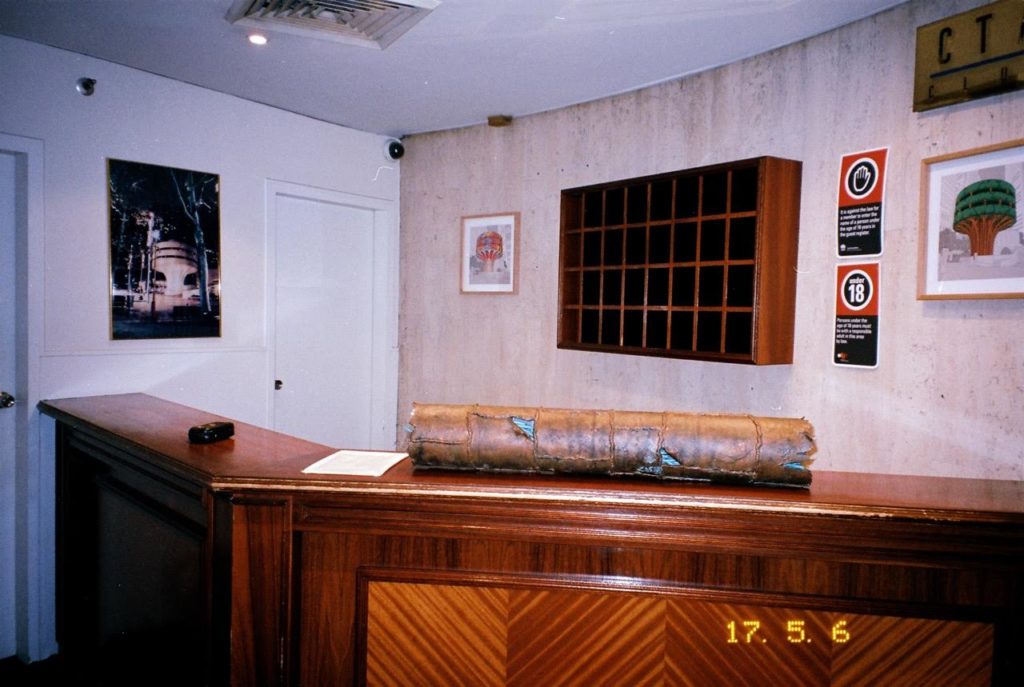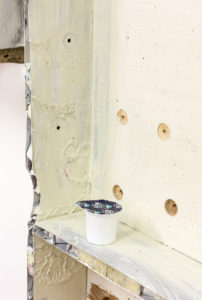“The idea was that it all blurred into one extended experience of viewing exhibitions in different ways,” writes Conor O’Shea in an email, not long after we’d met for the first time. The artist-curator who runs the confusingly-named art space Sydney in Sydney, Australia, was all exuberant, youthful energy as he breathlessly explained the concepts and motivations behind his networked, organic, entangled practice, while walking down Oxford Street towards his studio. We’d started in his bedroom, a bare room in a standalone cottage in the pricey inner-city suburb of Paddington, with access through the kitchenette. O’Shea lives there cheaply by a fluke and — like many aspiring artists and curators in notoriously expensive cities — it doubles as his gallery.

Melbourne-based artist Lewis Fidock‘s meticulously process-driven Constipated Thinking — in the form a pair of painstakingly and artificially-aged pair of track pants and a backpack bearing a fake baby bump — graced the empty, terracotta-tiled room. A preserved dead spider was tacked to the corner of a wall, next to some electrical fittings. O’Shea’s mattress was stored, out of sight, in the shower.
Opened in February 2016, Sydney has presented the work of the likes of Viktor Timofeev, Ed Fornieles, Adriana Ramić and more, in both solo and group exhibitions, independently and resourcefully. Modest and DIY, the deeply networked and international bent of the programming was what caught my attention in the first place, our eventual meeting in the rainy beginnings of summer in New South Wales credited to the networked ‘coincidences’ of online-aware art. But beyond the latticework of friends, acquaintances and colleagues that intersect at Sydney, there’s a deep DIY history and complex conceptual bearing underpinning it.
Inspired by projects like Gambia Castle, Y3k and CBD Gallery, and expanding with a collaboration with now-defunct Sydney art space Minerva, the integrative element of the project peaked at a solo exhibition by O’Shea called Thank you for your email and your interest, but this won’t be possible and a group exhibition called We Remember It For You Wholesale (Part Two) in 2017. Co-presented by Sydney with Minerva manager S.T Lore, the latter show was named after said non-fiction writer’s work, written in the lobby of the CTA Business Club hotel where We Remember It… was finally presented. At the same time, O’Shea was moving his mattress out of his tiled bedroom for the 2021 group exhibition — including Marina Pinsky, Quintessa Matranga, Anna Solal and other — which was the first show I came across by an elusive space called Sydney. Pinsky, incidentally, is showing there solo this time, her Flight 714 to Sydney on now to May 6. It makes sense then, that O’Shea and I would revisit the history and the thinking behind the diversified and cross-platform project as our narrative, at least, comes full circle.
**Why is this idea of blurring “into one extended experience of viewing exhibitions in different ways” important to you as an artist and curator?
Conor O’Shea: I think it is important to view exhibitions in different ways, it really excites me to see objects in different scenarios, we cannot always for the rest of time see shows just in gallery spaces. There has been such a rich history of viewing exhibitions in different ways and places, which will continue. I am excited about people who self-organise, making something out of nothing. This type of energy creates stimulation and positivity and is very important to me.

**What is it about the “in-between areas of curator, artist, space and manager” that interests you?
COS: I am interested in facilitating exhibitions, making, and meeting people around the world, I enjoy both organising, managing and making equally. They complement each other. I enjoy feeding all the energy from in-between areas back into themselves, I believe collaborative activities create positivity, and my aim into the future is to continue this combination. I am interested in how in-between areas bring you to a place you have never been before and open possibilities that just making art cannot reach.
**Do you think this sort of diversified practice is a symptom of, as well as a remedy for contemporary culture and how it functions?
COS: I definitely think this sort of diversified practice is a symptom of contemporary culture. It is interesting you say ‘remedy,’ because diversified practice functions as a remedy for me, working in diversified areas allows me to work in an expansive area. For me, it’s a relief because I don’t have to do one thing all the time. Diversified practice has been around for along time, everyone is just so much more connected and aware than ever before, I feel it is constantly taking on new shapes.

**I wonder if it is as much adaptive as it is responsive to the ‘amateurisation’ of the art, and other, industries…
COS: Amateurism is important, like being naive, I believe not being so calculated is a good thing.
**Obviously, URL documentation of IRL exhibitions as a form in itself has become a hot topic, given the changing way people engage with art on the internet. Do you have any thoughts on this shift?
COS: Definitely. Ever since professional documentation has existed, things have changed. I went to a talk recently by the early Biennale of Sydney curators and they discussed how in the past they would hardly document shows, ‘had no budget, ‘very DIY. It wasn’t on there mind, they where present. They just took images on a small point-and-shoot film camera and didn’t even care. Could you imagine that happening now? I just scrolled though an entire PDF of that Biennale from 1992 that I found deep in the internet. It had just little film photos and, to be honest, I thought they looked way more interesting, more realistic. I enjoyed the atmosphere that was captured by the way the light would fall, they look timeless, I actually took time looking at these images.
I do love engaging with the internet and looking at shows online, especially seeing I cannot be there because I am in Sydney, so I am grateful for the people who do document things clearly and scientifically. I also document things professionally. I also document on a film camera sometimes, or using my phone, this is my way of somehow having a middle ground. For that Minerva show, S.T Lore and I commented on this. It was his idea to document on film with a crime scene-type flash, and the objects reacted in stunning way, it was so atmospheric. The show was then documented cleanly at Minerva, so the objects existed in both the clinical context of a gallery and the atmosphere of a hotel.**
Marina Pinsky’s Flight 714 to Sydney is on at Sydney’s Sydney, running March 24 to May 6, 2018.














